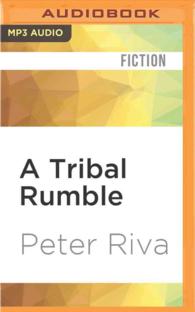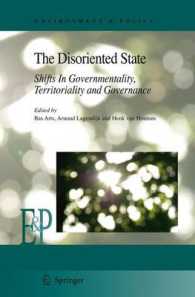- ホーム
- > 洋書
- > 英文書
- > History / World
Full Description
Benedictine scholars around 1700, most prominently proponents of historical criticism, have long been regarded as the spearhead of ecclesiastical learning on the brink of Enlightenment, first in France, then in Germany and other parts of Europe.
Based on unpublished sources, this book is the first to contextualize this narrative in its highly complex pre-modern setting, and thus at some distance from modernist ascriptions ex posteriori. Challenged by Protestant and Catholic anti-monasticism, Benedictine scholars strove to maintain control of their intellectual tradition. They failed thoroughly, however: in the Holy Roman Empire, their success depended on an anti-Roman and nationalized reading of their research. For them, becoming part of an Enlightenment narrative meant becoming part of a cultural project of "Germany".
Contents
Preface: How to Read this Book
1 "Germania Benedictina"
1.1 Layers of Time - Between Trent and the Enlightenment
1.2 Layers of Space: "Benedictine Europe"
1.3 Layers of Knowledge: Religious Communities in Early Modern Central Europe
1.4 Layers of Demography: Being a Benedictine monk
1.5 On Sources, Bibliography, and Terminology
1.6 Summary
2 Multiple Perspectives - On the Same Object?
2.1 Introduction
2.2 "Die Forschungszentren der deutschen Benediktiner" and the "Katholische Frühaufklärung"
2.3 "Enlightened Monks" - and "Monastic Humanism"
2.4 Making Monks Enlightened: The Late 19th and Early 20th Centuries
2.5 Benedictine Tradition(s)
2.6 Looking Ahead from 1700: The Making of "Enlightened Monasticism" in the 18th Century
2.7 Looking Back from 1700: 1200 Years of Prehistories for Benedictine Scholarly Practice
2.8 Summary
3 Knowledge, Institution and Conflict in the Benedictine Context
3.1 Introduction
3.2 The Inner Circulation of Knowledge: Congregation, University, or Academy?
3.3 German and French Benedictines
3.4 The Protestants: Res publica literaria and Germania
3.5 Knowledge, Required: The State, the Church - and the Aristocracy
3.6 Diverse Publics, Diverse Censorships
3.7 Conflict and Dissent in the Benedictine Context
3.8 Conclusion: On the Institutional and Epistemological Implications of Knowledge Change
4 Tropes and Metaphors of Monastic Knowledge
4.1 Introduction
4.2 "Reform", "Revolution", and the "Old-New"
4.3 Four Exemplary Ambiguities: "Aufklärung", "Light", "Learned Nuns", "Monkish Fables"
4.4 "Criticism" and "Scholasticism"
4.5 Conclusion
5 A Reclassification of Knowledge?
5.1 Introduction
5.2 Philosophy
5.2.1 Challenges, 1: Benedictine Thomism - Unsuccessfully Contested
5.2.2 Challenges, 2: The Assimilation of Christian Wolff
5.2.3 Trends, 1: Mathematics, Nature and Observation
5.2.4 Trends, 2: Moral Philosophy
5.3 History and Criticism
5.3.1 Challenges, 1: (Multiple) Proof - and (Individual) Taste
5.3.2 Challenges, 2: On Historicity
5.3.3 Trends, 1: The "Order" as Framework
5.3.4 Trends, 2: "Germany" - and "Austria" as Frameworks
5.4 (Canon) Law
5.4.1 Challenges: The Negotiable Status of Monastic Rules and Habits
5.4.2 Trends: "Germanized", "Naturalized" and "Historicized" Canon Law
5.5 Theology
5.5.1 Challenges: Scientia Media, Peccatum Philosophicum
5.5.2 Trends: Positive Theology, Mystical Theology - or Practical Theology?
5.6 Summary
6 Conclusions, Inheritances, Limits, Confessions
6.1 Introduction
6.2 Should We Speak of a "Monastic Enlightenment"? And if so, What Came before It?
6.3 On Methodology
Sources and Bibliography
Index







